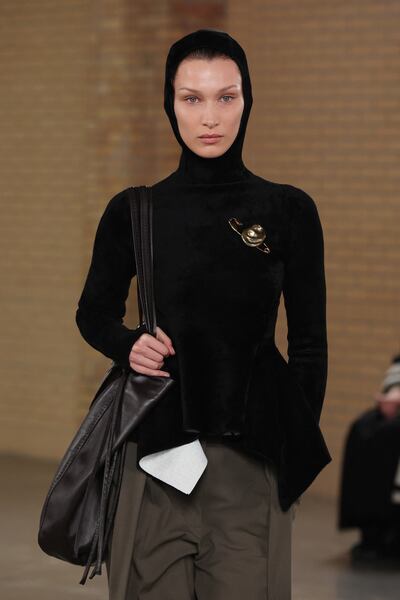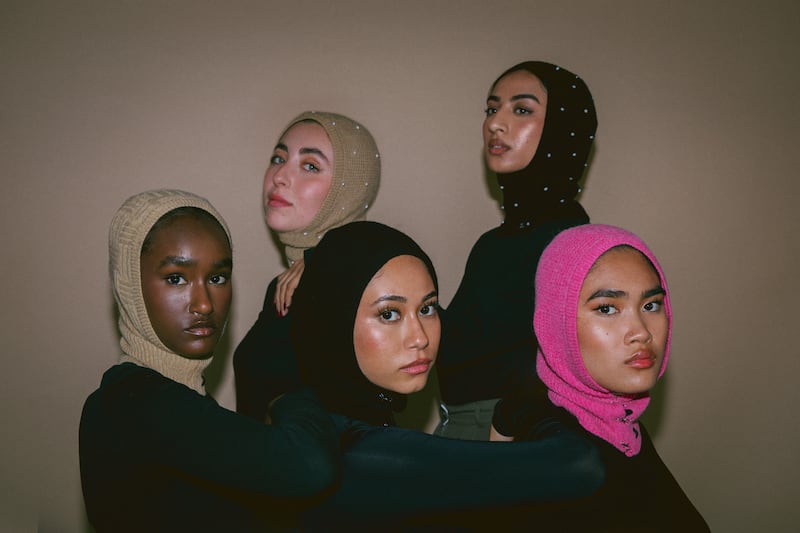I’m scrolling through the new-in pages of ASOS from my phone when my thumb stops. The product that has caught my eye is a multicoloured crochet balaclava — a detachable hood that simply slips on to the head.
I keep scrolling and I am met with another design, this one in a solid hue of peacock blue. Yet another appears in a shade of baby pink, with drawstrings to make it fit more tightly around the face. The most expensive of the three, at Dh200, the pink balaclava is already out of stock.
I can’t help but think how this micro-trend will resonate with hijab-wearing women: will they adapt it to their own winter wardrobes or denounce it as yet another instance of the double standards Muslim women face in some parts of the world about “traditional-looking” head and face coverings?
Balaclavas were introduced as a winter style trend two years ago, when labels such as Marine Serre and Miu Miu showcased versions on their autumn/winter 2021 runways. A year later, the head covering’s popularity was further cemented, when it was seen on the 2022 runways of Gucci, Max Mara and Proenza Schouler — with one piece being modelled by Bella Hadid. The style has now trickled down to the high street, with balaclavas available from H&M, Topshop, Monki and more.

“The balaclava is trending, which is convenient for hijab-wearing women, and especially for Muslim sisters who live in or visit cold countries,” says French-Moroccan modest-fashion influencer Hanan Houachmi, who lives in Dubai. “It’s easier for them to wear something that actually stays on the head even better than a beanie. It’s a new, warmer option, but I would prioritise purchasing it from hijabi brands.”
Bringing the balaclava home
Recognising the synergy between balaclavas and hijabs, and identifying a gap in the modestwear market, American headscarf brand Vela recently launched its Velaclava line made especially for hijab-wearing women.
“The inspiration for this collection came when I was planning a trip to Iceland. I knew I wanted a warm scarf for my cold vacation destination, but the balaclavas in the market didn’t have enough modest coverage for me,” Vela co-founder Tasneem Sabri tells The National. “Temperatures in some places are at zero degrees Fahrenheit, and a woven or chiffon hijab just won't keep you warm enough. So, we have to get creative and wear a beanie on top of hijabs or another thicker scarf that, let’s be real, can be very uncomfortable.”
Vela’s balaclava designs, which took a year to conceptualise and produce, are hand-knit with 100 per cent wool and feature longer neckpieces for more coverage. Available in black, pink and sand tones, some are dotted with freshwater pearls and others are decorated with minimalist silver fasteners, catering to both feminine and edgy aesthetics.
Why balaclavas might be misunderstood
While the Velaclava launch was highly anticipated — some styles sold out within 24 hours of launching — Sabri says the team received a few comments from critics claiming they were using a fashion garment in lieu of a religious headscarf.
“Our response was a hijab is a hair covering. No ruling specifies which textiles and design elements can or cannot be used. Our intention is straightforward: to create a hijab or head covering that is comfortable, functional and fashionably appealing,” says Sabri.
The brand was also motivated to put its mark on on-trend head coverings — a niche that may be gaining currency in fashion, but is still stigmatised in certain political circles when worn by a certain segment of women.
“The double standard is real,” says Sabri. “When a supermodel wears a balaclava on a runway, it’s fashion, but when a Muslim woman wears a similar head covering, it’s oppression. We think the stigma will remain unless Muslim women continue to challenge it.”
The rise of the balaclava has not been without controversy. This time last year, when the accessory was surfacing on runways and social media, some Muslim women pointed out the irony — that even while covering one’s head was becoming more popular in the mainstream, the Indian state of Karnataka was outlawing hijabs in schools and the French senate was voting to ban hijabs on Muslim women playing sport.
A head covering that is deemed trendy on one woman is seen as a symbol of religious extremism on another.
The same but different?
While some women may choose to swap the traditional hijab for a balaclava for religious or modest reasons, Palestinian artist Nemah “Nemahsis” Hasan recently used TikTok to point out differences in perception. The singer, who lives in Toronto, donned a woolly balaclava for her debut single What If I took it Off for You?, and often wears the style in her personal life.
However, recently she had her balaclava removed from her head for security reasons by female personnel at the airport, who had no idea that Hasan was wearing the garment in lieu of a hijab. The staff member was apologetic when she realised her mistake, but Hasan says she understood then that others may perceive the balaclava as just another form of a hoodie.
In that sense, far from being a case of cultural appropriation, a balaclava cannot be conflated with a hijab. The accessory has its roots in the West, and was made in the 1800s to keep British soldiers warm in the winter. It’s also often worn by winter sports athletes.
“We used to sell them at a ski resort that I worked at. A lot of people were wearing balaclavas way before they ever heard about Islam,” says Houachmi. “Many things are unfairly politicised, but we can’t argue every single thing that’s related to covering a head. I think we tend to get caught up in the offences and the unfairness, and then all those frustrations build up and we start debating things that are not a debate. The balaclava isn’t a debate; it isn’t ‘ours’.”
Houachmi evidently has mixed feelings about balaclavas, because she believes that an important function of the hijab is for it to be an obvious identifier of a Muslim woman. “I also wear balaclavas, so I’m not judging. However, it isn’t an item that makes an obvious, clear statement that we’re Muslim women,” she says.
World Hijab Day, first celebrated on February 1, 2013, aims to support the millions of Muslim women who choose to cover their hair, by encouraging other women to experience the hijab for a day. And while head coverings might be less conspicuous now with turbans, hoodies, durags, bandannas, bucket hats and balaclavas in vogue, it’s important to remember that this day was founded a decade ago in solidarity with Muslim women who make the empowered choice to cover their hair despite societal prejudice.
Nonetheless, the balaclava, which has ascended from humble beginnings to the world of high fashion, can be a stylish head-covering hack for hijab-wearing women. Those who are creatively working the headpiece into their winter wardrobes may also be helping to dispel Islamophobic stereotypes about Muslim women — that they are oppressed by modesty, that modesty is unfashionable, and that women who cover their hair only do so in one traditional style.






